Today’s graphic comes from Thomson Reuters. It charts the success of 3D movies that have been released and how long those movies stayed in the theatres.

Credit for the piece goes to S. Scarr, G. Cabrera, and K. Pong.
Today’s graphic comes from Thomson Reuters. It charts the success of 3D movies that have been released and how long those movies stayed in the theatres.

Credit for the piece goes to S. Scarr, G. Cabrera, and K. Pong.
Today’s post is a small interactive from the Wall Street Journal that allows the user to explore consumer spending not by category of spending, but rather the type of store in which they are spending, e.g. grocery retailers. Consumer spending is a fairly important measure of the US economy since so much of our economy depends upon it (I want to say roughly two-thirds, but I cannot recall exactly).
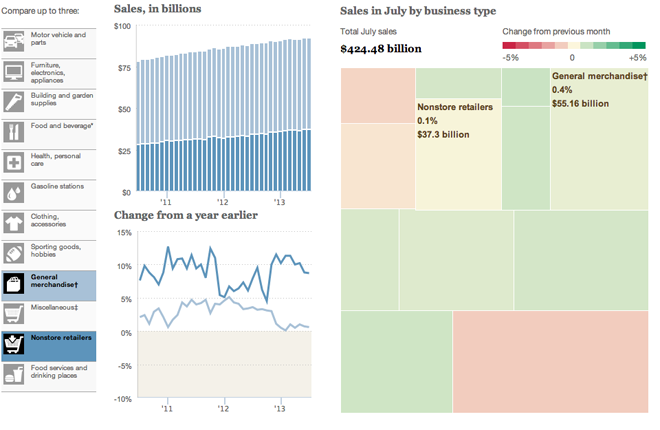
This piece has a few interesting things going for it. Firstly is the ability to compare and contrast three different retail channels (My screenshot compares only two). An unlimited amount would have been far too many, but three is a manageable number, especially in the various charting components used.
The tree map is interesting. I like the idea of using them, but I am not sure this is the best application. First, a tree map is fantastic for showing hierarchy. If, for example, there were sub-channels of the big retailing types, they could be nested within, well, squares or rectangles. But here the size and growth could have been compared perhaps more easily in a scatter plot. Secondly, I cannot determine the order for which the channels have been arranged. Clearly it is not by size, because the small ones are near the top. Nor is it reverse, because there are smaller ones where there should be larger ones.
Then the bar chart. An interesting idea, to be sure, of aggregating the sales per channel to see their total value. But if the goal is to compare them, would not a line chart looking at both separately not in aggregate show size and relative gains/declines against the other?
Credit for the piece goes to Dan Hill.
Driving can be dangerous. But perhaps most so in the developing world. The Pulitzer Center created this interactive map to allow users to explore just how dangerous driving can be.

Little windows provide details on countries the user rolls over. This data looks at deaths per 100,000 people, killer/victims, and lastly a rating of law enforcement across several different issues. The map also includes links to stories on the website as well as an information panel that related small bits of information about selected countries.
Credit for the piece goes to Tom Hundley and Dan McCarey.
A few weeks ago the Washington Post published a graphic that explained how space weather can have significant impacts on Earth. This is more of an illustrated diagram and less of a data visualisation piece, but it still worth a read. Why? Because, if scientists are correct, the sun’s magnetic poles should soon finish a polarity reversal. And that creates the potential for some stormy space weather.
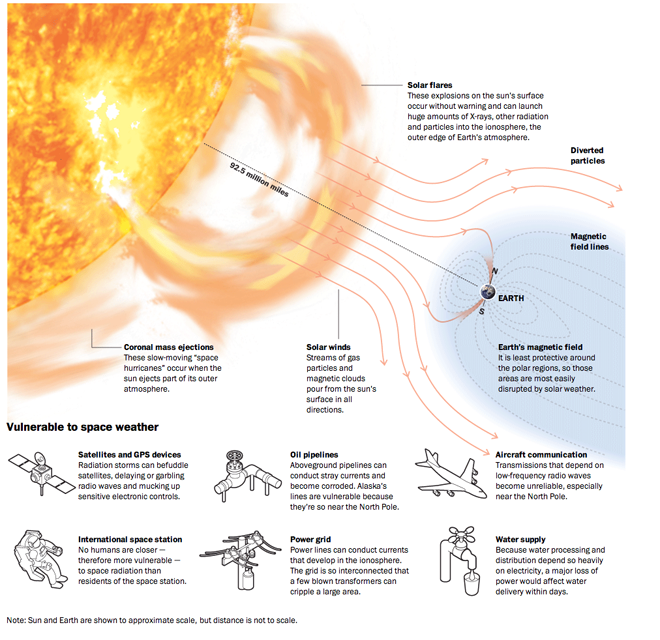
Credit for the piece goes to Bonnie Berkowitz and Alberto Cuadra.
Earlier this summer I looked at a graphic by Thomson Reuters that compared life expectancy changes across the world from 1990 to 2011. Last month, the Washington Post published an interactive graphic that explores life expectancy (along with obesity and physical activity) across the United States from 1985 to 2010.

What I really enjoy about the piece is that each toggle for the health condition, i.e. life expectancy, obesity, physical activity, the text beneath swaps out to explain what the story is. Context is key. But then the ability to flip between the actuals and the growth for both men and women allows the user to really explore the data. And to see that growth or lack thereof is not even across the sexes.
From the design side, a minor point worth noting is the use of different colour palettes based on the mapped metric. The actual values (with the greater range) use a darker green-blue and tint that down whereas the growth values (all of three conditions) are in a different palette. Here it works, though I am more accustomed in similar pieces to seeing the swapping of palettes for changes in the mapped metric.
Beneath the big map, however, are two components also well worth the user’s attention. Perhaps deceptively simple, two sets of line charts, they add (again) context to the data. For example, while it is great to see life expectancy in the United States improving, when you compare that to the rest of the developed world, we are falling behind.
Overall a solid piece.
Credit for the piece goes to Patterson Clark, Kennedy Elliott, and Katie Park.
At lunch, I felt inspired enough to create a quick chart that looks at some urban population statistics.
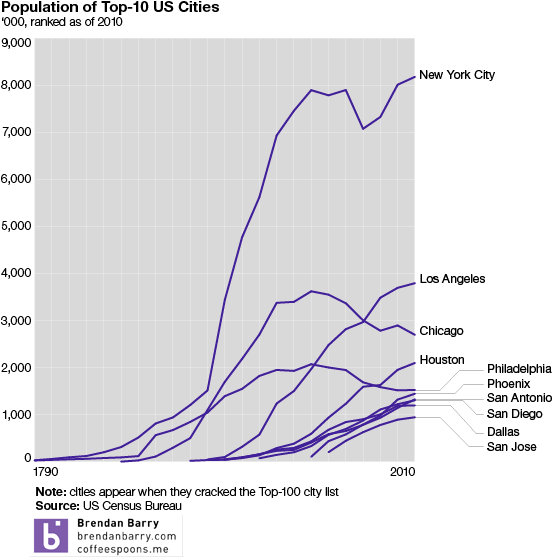
A caveat about the data, it comes from the Census Bureau’s tables on the top-100 cities. So until a city appeared on that list, I did not chart it. The exceptions are 2000 and 2010, where I pulled directly from those census results. Mostly because it was lunch and I needed to be quick about it.
Hint, US Census Bureau, make your interface more friendly.
Credit for this goes to me.
Happy Friday, everyone. Today’s post comes via colleagues of mine in London, who shared with me the Guardian’s selection of 16 useless infographics. They are shit infographics. Well, at least one is. Check them out and you’ll understand.
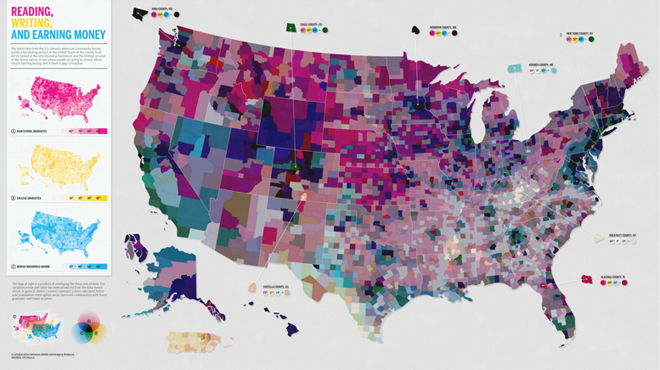
Credit for the selection goes to Mona Chalabi. Credit for each infographic belongs to the infographic’s respective designer.
Today’s piece is a map from the Economist. It looks at the state of nuclear energy across the world. Slovakia caught my eye because when I recently traveled across that country I glimpsed from my train the massive complex near (I think) Trnava. Apparently those are also some of the youngest reactors out there.

Credit for the piece goes to O.M. and L.P.
A map? Again? I know. But trust me, this one is interesting. For those of you who do not know, Boston’s Thomas Menino is not running for reelection this year. By the time he leaves office, he will have been the mayor of Boston for over twenty years and so this year is the first open election in a long, long time.
So what’s better than graphics for election-related data? Graphics with a medieval/Renaissance/fiefdom aesthetic, that’s what. With a little bit of fun, the Boston Globe mapped out the local areas of strength for the 12 candidates for mayor. The residence of each is denoted by a castle keep while areas of strength, location of donors, and key voting areas are signified in different colours. And the map’s background? Well, you can see for yourself.
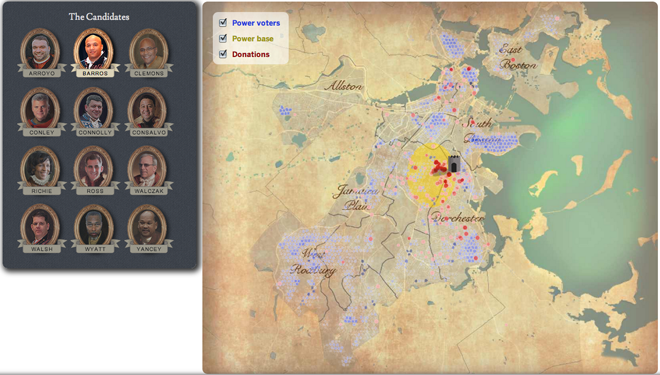
Credit for the piece goes to Alvin Chang, Andrew Ryan, Javier Zarracina, and Matt Carroll.
I don’t often write about maps, especially of the choropleth kind. In many cases I choose not to because so many of the maps are one-dimensional: how fast is x growing across the world; which is predominant across the world, y or z? So I was pleasantly surprised by the Economist yesterday when they published this interactive map on the scourges of hepatitis and HIV.

Quickly put, the map is a success. It shows a clear geographic pattern; the developed/Western world along with the Middle East and Asia have a larger problem in hepatitis than HIV whereas Africa and Latin America are dealing moreso with HIV. (Admittedly, the fact that 117 out of 187 countries are dealing more with hepatitis is lost because so many of the countries are small in area.) But, the really nice bit about the map is not just the colour by virus, but the tint by comparative ratio. The darker the colour, the stronger the one virus over the other.
Lastly, from a data perspective, I just wonder if the ratios could not be adjusted for population, or deaths as a percentage of the national population? I would be curious to see if that would yield interesting results.
Credit for the piece goes to C.H., R.L.W., J.S., and D.H.